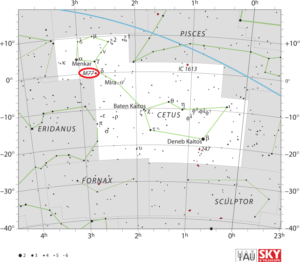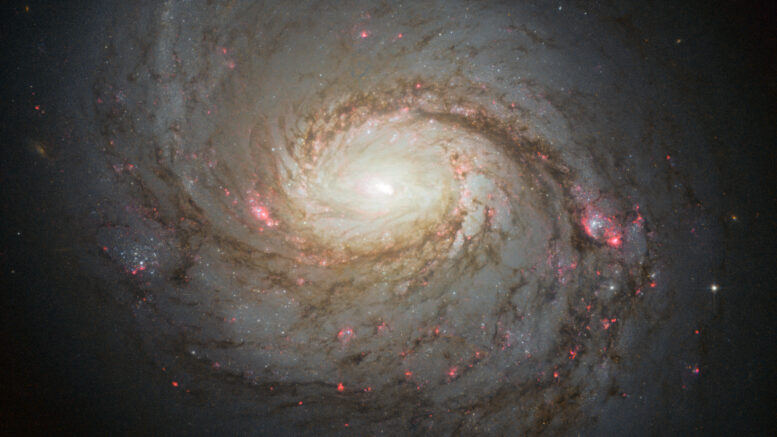Messier 77 (M77), also known as Cetus A, is a barred spiral galaxy located in the constellation Cetus. It is one of the largest Messier objects to be in the catalogue.
| Description | |
| Visible From Pacific Northwest | September To January |
| Best Time To Observe | November and December |
| Minimum Size Of Viewing Device | Binoculars |
| Object Type | Barred Spiral Galaxy |
| Designations | Messier 77, M77, Cetus A, NGC 1068, PGC 10266, Arp 37, UGC 2188, APG 37, AT20G J024240-000046, 3C 71, 2E 649, 2E 0240.1-0013, IRAS 02401-0013, 2MASX J02424077-0000478, MCG+00-07-083, MRC 0240-002, NRAO 112, PKS J0242-0000, RBS 348, Z 388-98 |
| Right Ascension | 02h 42m 40.7s |
| Declination | -00°00’48” |
| Constellation | Cetus |
| Number Of Stars | More Than 300 Billion |
| Apparent magnitude | +9.6 |
| Apparent dimensions | 7′.1 x 6′.0 |
| Object Radius | 85,000 light years |
| Distance From Earth | 47 million light years |
History
Messier 77 was discovered by the French astronomer Pierre Méchain on October 29, 1780. Méchain described the object as a nebula.
Charles Messier added M77 to his catalogue on December 17, 1780, describing it as a star cluster with some nebulosity. He noted, “Cluster of small stars, which contains some nebulosity, in Cetus & on the parallel of the star Delta, reported of the third magnitude, & which M. Messier estimated to be hardly of the fifth. M. Méchain saw this cluster on October 29, 1780 in the form of a nebula.”
Like Messier, William Herschel believed the object to be a cluster, but his description of it changed several times over several decades. After seeing it in a 7-foot telescope in 1783, he described M77 as an “ill defined star, surrounded by nebulosity.” Between 1801 and 1810, he observed it in his 10-foot instrument and noted that it had “almost the appearance of a large stellar nebula.” In the same period, he observed the galaxy in his large 10-foot telescope and noted, “A kind of much magnified stellar cluster; it contains some bright stars in the centre. With 171 its diameter is 1′ 17″; with 220 it is 1′ 36″.”
Lord Rosse included M77 on his list of 14 “spiral nebulae” discovered to 1850.
American astronomer Halton Arp included M77 in his Atlas of Peculiar Galaxies as the entry number 37, describing it as a “Spiral with a Low Surface Brightness Companion On Arm.”
Locating M77 In The Sky
Messier 77 can be found about 1 degree to the southeast of Delta Ceti, a subgiant star with a visual magnitude of 4.08. The galaxy is located only a few degrees away from Mira (Omicron Ceti), the famous red long-period variable star.

Viewing M77
The best time of year to observe M77 is during the autumn. The galaxy is easy to spot with binoculars as it is quite compact and has a bright core. Small telescopes will reveal a fuzzy ball of light with a bright centre, and 4-inch instruments will also show the galaxy’s oval halo. 8-inch and larger instruments reveal the details of the galaxy’s structure.
Photographing M77
Messier 77 isn’t necessarily the most popular target, but there are some great websites with some tips and help for those looking to image the object. The best way to find tips will be in the links below or astrobin and cloudynights. The larger the telescope, the more detail will be revealed, but also will the capture time will increase.
http://deeplook.astronomie.at/laplama_blauensteiner_sdp_m77.htm
http://kentbiggs.com/images/galaxies/M77.htm
https://www.astrobin.com/aewvat/B/
Sources And Further Reading
Descriptions of all of Messier Objects can be found here.
https://www.nasa.gov/feature/goddard/2017/messier-77
https://www.messier.seds.org/m/m077.html
https://freestarcharts.com/messier-77

Be the first to comment on "Messier 77"